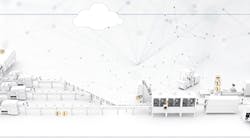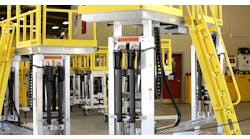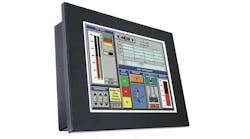Over the past few years, some trends have emerged under the Industry 4.0 (I4.0) and IIoT umbrellas. These range from smarter sensors that can be attached throughout the equipment to gather data where previously it just wasn’t feasible to cloud-computing solutions for aggregating and analyzing this data to be used for services such as asset-performance monitoring, preventive maintenance and digital twinning. These solutions are rarely core to the equipment, but, even without a one-stop-shop solution, the driver here is the value these additions bring to the end user through lower unplanned downtime, increased OEE and other direct operational benefits.
B&R has introduced products with features designed to maximize the capabilities of equipment by increasing throughput, efficiency and flexibility, which is valuable to OEMs and integrators that want to leverage their offerings to end users. Industry often thinks of adaptive systems such as ACOPOStrak and ACOPOS 6D as replacements for traditional motion systems like conveyors or dials. B&R wants to change this thinking and show the industry that, by considering these technologies as the platform to build a system, it will become easier to quantify the value these products bring through their more-seamless fit with the data gathering and analysis trends that are driving these I4.0 and IIoT trends. Using ACOPOStrak and ACOPOS 6D provides advanced motion control, integrated process control and high-quality system data from the heart of the machine without the integration steps of piecing together a custom solution.
Derrick Stacey is based out of Atlanta and has been with B&R for the past nine years. He spent most of his career focusing on the adoption of mechatronic systems such as ACOPOStrak, SuperTrak, and ACOPOS 6D into the field and educating everyone from controls engineers and plant managers to directors of innovation on how they can benefit from such systems. It started with early digital twins and feasibility studies to fully realize automated lines based on these leading-edge technologies. He is the Global Product Manager for ACOPOS 6D and SuperTrak product families at B&R.
global product manager,
ACOPOS 6D and SuperTrak
B&R Industrial Automation
Q: The automation industry is always hearing technology suppliers talk about how much faster, better and more flexible a new product is. Why is B&R looking at this differently?
A: We see those statements as incremental improvements. And by no means has continuously improving our products and solutions become unimportant, but rather we need to look at specifically the mechatronics technologies, the track systems, ACOPOStrak, planar systems, like ACOPOS 6D, and what we see that they can offer, such as more value, when we’re not simply asking them to be faster and more flexible transport or conveyance. The value that you uncover really comes to a step change. When you look at it from a holistic approach of starting to design with these technologies at the core of the machine and the machine line, that’s where the real innovation and differentiation is created.
Q: You mention these technologies as a platform instead of as a group of motion products. What is the distinction?
A: If I can move 10% more things through my machine, that’s a data point which I can use to say, “Okay, how does it affect my throughput overall?” There are bigger questions asked of machine builders and integrators from the end user. How do I get more data out? How do I anticipate issues? How can you help me run my factory better and make sure my products are better and have more intelligence around them? Yes, 10% more will sell a machine, but it only goes so far to really answer the burning questions.
My experience over the past few years is working on educating everybody that I talk to about how to leverage these technologies. Often we’re dragged into a “smarter conveyor” sort of conversation, and it operates under the same principles as a servo. Now, we start to shift the discussion to motion profiles, RMS current, loop tuning. But all of a sudden you’ve sort of put a box around what it brings, because you’re just seeing it as purely transportation, using the servo as an analog. But to really see them as a platform changes your thought process, and it can bring the highest possible value when used as the foundational technology.
These technologies are often designed to bridge the mechanical, electrical-controls and even digital-services needs of the next generation of machines. When you think of it more as a platform, it’s not just how fast it goes and how much current I get out of it. What data does it give me? How can it change or improve my overall architecture from a controls perspective? How can I leverage and give more freedom and flexibility for my mechanical designers to use that sort of cleverness and some of that experience they have? Once you take it off the table of focusing only on timing charts and motion profile, that creativity and that engineering juice starts to flow, and you can get something more than the sum of its parts.
Q: Can you explain in more detail how ACOPOStrak and ACOPOS 6D merge various transport and process functions within OEM equipment?
A: This is where the fun is, where the designers can really run a little bit more freely. In the simplest use case, we take the standard approach, which is how do we leverage the controlled motion that these transport systems bring to remove external axes of motion from their process, to shrink process station equipment, to simplify it by putting a little bit of that motion burden on the transport system, because it’s more accurate? It’s got more controllability than a standard conveyor or an indexing ring.
But when we start to look at letting its scope expand, now you could add sensor data. You can start to do audit trail. You can start to add things without product sensors all over your machine, which eliminates a lot of wiring throughout the whole scope of it. You don’t have to have as many product sensors on machines that they need to check at each step. That can all be driven into the smarts of the transport system. And now your machine starts to change. Just the shape of it can also be a big change here.
Often with traditional systems, you’re building your equipment around the outside, with constraints, you’ve got mechanical things that are all filling your space. You’ve got drive trains you’ve got to keep an eye on. Now, you can use the volume and height above your system or inside the track space. And the area that you’re using inside of your factory floor becomes maybe a little narrower, a little taller, that’s sort of free space, free volume inside a manufacturing plant. You might be able to fit two lines where one might have been, using a traditional system. You’ve got a whole new dimension to take advantage of, just by its very nature. And that’s really only scratching the surface.
Q: It is important to discuss as much the possibilities as the reality here. When can these trends be realized using B&R’s platforms?
A: I frame it up as, mechanically speaking, everything is there. We’ve got the products out in the market, people are using them. But we’re starting to see people get a much more mature digital strategy, a much more mature understanding of how the edge or how the cloud can benefit operations as a whole. And once you put these systems in place, you start to design your equipment to lend itself to these connections. What’s kind of cool is, because the hardware is there and all the data is behind it, the tracking of wear life, the tracking of friction, the tracking of just how the system itself is operating is achievable.
The IT-OT infrastructure is something everybody has been chasing, and now we’re starting to see whole digital platforms and a lot of integrations with AWS and Azure. The missing point is just people pushing their machine designers to leverage both ends. With the track systems, ACOPOS 6D and ACOPOStrak, the data behind them is there; it’s just that connection point.
It’s on the designers to leverage that information. You leave a good bit on the table when you don’t utilize it. The business case is still there. But that’s where we’re going to start to see step changes in value is utilizing that, in scraping the system for all that really good core data for how the system’s operating, and then pushing that through to the HMI, showing KPIs, operators passing it up to the edge or the cloud for big data. I see a spectrum on the enterprise level and on the machine level, and we’re slowly bringing that information up from the sensor to the cloud.
For more information, visit www.br-automation.com.





